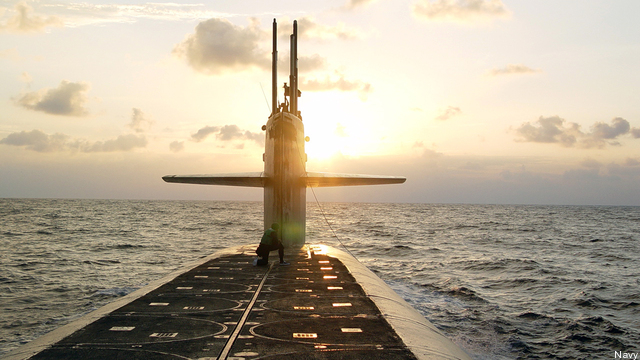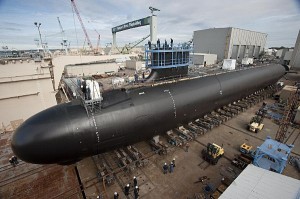
An Ohio-class nuclear missile submarine (SSBN). The Cold War-era Ohios are heading into the sunset, to be replaced by the new Columbia class.
WASHINGTON: Pentagon procurement chief Frank Kendall just approved the Navy’s top-priority program, the Columbia-class nuclear missile submarine, to start detailed design work and engineering. Known in Pentagonese as a Milestone B decision, undersecretary Kendall’s okay lets the Navy spend the $773 million Congress voted for the program in last month’s Continuing Resolution. [CORRECTED:] The projected procurement cost for is $96 billion for 12 submarines; the cost of the whole program, including R&D, is $128 billion.

Rep. Joe Courtney meets with young submarine officers.
“If we had had a Milestone B announcement today but no money… you would have really sort of an empty event,” said Rep. Joe Courtney, the ranking Democrat on the House seapower subcommittee. “Without that $773 million, we’d still be twiddling our thumbs waiting until March,” when a final 2017 spending bill is expected. But now, with the Milestone B decision and 2017 funding in place, Courtney said, “that money is going to move fast… paying EB [Courtney’s homestate shipyard, Electric Boat] and some of the other vendors.”
So, like a nuclear missile that can’t launch unless two officers both turn their keys, the Columbia needed both Congress and the Pentagon to act. Now they both have, and it’s up to the Navy and the shipyards: New England’s Electric Boat and Virginia’s Newport News. But keeping a program this costly and critical on schedule and on budget will be a high-stakes high-wire act.
The schedule is especially challenging because the Navy itself says there is no margin for error. Even if everything goes right, the 14 aging Ohio-class subs that currently carry most of the nation’s nuclear deterrent will barely stay in service long enough for the 12 Columbias to replace them.”[Chief of Naval Operations] Admiral Richardson on down and [Navy procurement chief] Stackley as well have been adamant that there’s just no margin for delay in terms of this program,” Rep. Courtney told me “There’s tremendous momentum, [but] it’s still critical that it keeps hitting all the key timing milestones so we don’t run into delay problems.”

Frank Kendall visiting Bagram airbase in Afghanistan.
Staying on budget is likewise particularly tricky for a program that will be one of the Navy’s largest, with Kendall approving a total cost of $96 billion (in 2017 dollars). Specifically, the undersecretary approved 12 submarines at $8 billion each, which amortizes overhead equally over every boat in the class. That’s a marked change from normal Navy accounting, which bills all start-up costs to the first ship, a formula which would have priced the USS Columbia at (depending on the estimate) $10 to $14 billion. Spreading out the costs, as Kendall has, makes the first ship more digestible, both in the Navy budget and on Capitol Hill, and smooths out long-term spending.
It also helps fund continual improvements to keep up with the threat, said retired Navy submariner and strategist Cdr. Bryan Clark. “Spreading out the R&D spending over the entire program also implies the Navy believes it will continue doing R&D throughout [Ohio Replacement Program] construction,” Clark said. “Since the program will take about 15 years to build, it is likely new threats and capabilities will emerge, [and] sustaining robust R&D investment throughout the program will enable the Navy to incorporate new technologies into the ship, which could then be backfitted into completed SSBNs.” (The Navy’s done something similar to keep its Virginia-class attack subs up to date).
On the other hand, this amortized approach only works if you know for sure how many vessels you’ll be building. It would make a huge mess if the program were cut short, as the Seawolf and Zumwalt classes were. So when the cautious Kendall bets that future administrations and Congresses will fund all 12 Columbia subs, that shows how non-negotiable the Defense Department considers this program to be.

Electric Boat’s submarine-building yard in Groton, Connecticut
It also shows how strong support is on Capitol Hill. To start with, the $773 million Congress voted for Columbia in December is not only a lot of money. It also makes the Ohio Replacement one of the few programs deemed special enough to get an exception from the normal rule of a Continuing Resolution, which is that all funding lines continue on autopilot at the same level as last year, with no provision to adjust existing programs or start new ones. Had the CR not included such an “anomaly” (as legislators call it), work on Columbia would have come to what the Vice-Chief of Naval Operations called a “screeching halt.”

Rep. Randy Forbes
But special congressional treatment for the Ohio Replacement goes back years. Led by House seapower subcommittee chairman Randy Forbes of Virginia — now the leading contender to be Trump’s Secretary of the Navy — and the panel’s ranking Democrat, Rep. Courtney, Congress created a unique National Sea-Based Deterrent Fund (NSBDF) to cover the staggering costs of the Ohio Replacement Program. Critics — including Kendall — were quick to call the NSBDF a mere accounting gimmick, moving costs off the Navy’s ledger without finding new money to pay for them. But Congress subsequently gave the NSBDF special authorities to spend money more efficiently than standard shipbuilding programs, which the independent Congressional Budget Office estimated “could potentially save several hundred million dollars per submarine.”
“Initial skeptics…of the Sea-Based Nuclear Deterrent Fund became more and more enamored of it, particularly as Congress granted these authorities,” Courtney said.
While Congress created and empowered the National Sea-Based Deterrent Fund, however, it hadn’t actually put any money into it. Even the Continuing Resolution put the $773 million into the normal “Shipbuilding & Conversion, Navy” (SCN) account rather than into the NSBDF. But language passed as part of the 2015 National Defense Authorization Act requires the Department of Defense to move any Columbia monies from SCN to the NSBDF. That’s what defense officials apparently did with the $733 million.
Considering top officials once wrote off the National Sea-Based Deterrent Fund as a gimmick, this is a big change. “There’ve been naysayers who’ve questioned whether the fund was ever going to amount to anything,” Rep. Courtney said proudly, but no more.

Bryan Clark
“The NSBDF was treated as essentially a theoretical construct by DoD since no money had been put into it yet by Congress,” said Bryan Clark. “I believe some in DoD thought — like the Ship Maintenance, Operations, and Sustainment Fund (SMOSF) for surface combatants — that NSBDF would eventually get some funding and could be a source of extra money for SSBN-related costs [i.e. on the margin]. They did not see NSBDF as an enduring or comprehensive source of SSBN funding. They are evidently now treating NSBDF as the source for all Columbia-related funding.”
Ironically, the main beneficiaries of the special fund for the Columbia class is arguably not the Ohio Replacement Program itself, but all the other, lower-priority naval programs that would get squeezed if they had to share the “Shipbuilding & Conversion, Navy” account with it.
“The Columbia class is such an urgent priority… it was going to get built even if it was part of the shipbuilding account. The question is what’s going to happen to the rest of the Navy,” Courtney said. “This is as important to [destroyers] and carriers and other ships as it is to the Columbia class.”

The Virginia-class attack submarine USS Minnesota under construction in Newport News.
“The concern of many in the Navy before NSBDF was established was that [Ohio Replacement] spending could take up 40-50 percent of the SCN budget if Columbia was funded directly from the shipbuilding account,” said Clark. “If that were the case, on the macro level shipbuilding funding could be flat or even increase in FY21 and later, yet the number of ships bought each year would go down, since almost half the SCN funding would be paying for a single SSBN.”
The Columbia submarines will still be immensely expensive, and — if deterrence works — they’ll never fire a shot in anger. But the Pentagon and Congress believe they’re critical, and now they think they’ve found an affordable path to build them.
Updated with clarifications and correction at 10:55 pm Jan. 4, 10:30 am Jan. 9.
SECNAV floats idea of co-production with foreign shipyards
Del Toro has repeatedly praised shipbuilders in South Korea and Japan for their abilities to keep construction efforts on time.


























